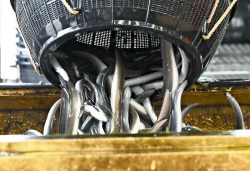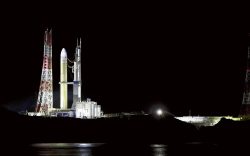Japanese Technology Advances Toward Moon Base Goal; Airless, Low-Gravity Environment a Construction Challenge

Komatsu Ltd. engineers operate a hydraulic excavator in a virtual space to check problems in Hiratsuka, Kanagawa Prefecture.
1:00 JST, October 12, 2023
Serious efforts are underway in Japan to build a moon base. Japan aims to bolster its international competitiveness in space exploration by taking advantage of remote-control technology that has been developed for purposes such as work in disaster areas. The Land, Infrastructure, Transport and Tourism Ministry has begun supporting private companies in their space exploration efforts, aiming to build a lunar base as early as around 2030.
¥100 mil. per kilogram of cargo
At a plant of the construction machinery maker Komatsu Ltd. in Hirastuka, Kanagawa Prefecture, engineers exchanged opinions saying such things as: “The machine should be lightweight and capable of drilling holes,” and, “To make it as light as light as possible, I want to avoid using coating materials.”
Komatsu aims to develop a hydraulic excavator to drill into the surface of the moon. The research and development is being conducted in a computer simulation of the lunar environment. This is the company’s first space exploration project.
There are quite a few issues ahead. It costs more than ¥100 million per kilogram to transport cargo from Earth to the moon. Simple extrapolation suggests that it would cost more than ¥300 billion to transport the 3-ton hydraulic excavator that the company is currently developing to the moon. To reduce the machine’s mass, the company is considering using carbon-reinforced plastics and light metals to build it, and doing without coating materials.
The lunar gravity, about one-sixth that of the Earth, also affects the company’s research and development. They found that, if a machine used on the Earth were to operate on the moon, the body of the machine would float up when it drills into the lunar surface. Engineers are making efforts to address the issue, such as adding weight to the machine and using tension rods.
Shunsuke Sugimura, 54, the manager of the research team, said: “While it is a difficult task, it feels rewarding to be involved in an inspirational project. I would like to see a Komatsu machine operating on the surface of the moon.”
Artemis program
Water, is thought to exist over a wide area of the moon. If so, people can drink it. They can even break it down into oxygen and hydrogen to make rocket fuel, expanding possibilities for further space exploration. The construction of a base for drilling into the surface of the moon and investigating the water and geology geological there will be an important step.
For that reason, the moon has caught people’s attention as a base from which to head further into the solar system, such as to Mars. The United States has been proceeding with the Artemis program since 2019, aiming for manned lunar landings and the construction of a lunar base, among other goals. Japan announced its participation in the program in 2019, and currently 29 countries have signed the Artemis agreement.
The Outer Space Treaty, signed by 114 nations, states, “Outer space, including the moon and other celestial bodies, is not subject to national appropriation by claim of sovereignty, by means of use or occupation, or by any other means.” How to proceed with lunar development is likely to be a topic of future discussion. In anticipation of further discussions, securing an advantage in this field is an urgent matter for many countries.
Learning from volcanic experience
For now, it is difficult for people to land on the moon and construct facilities in its airless environment. To address that problem, technologies to enable remote-controlled or automatic construction are important.
In Japan, relevant lessons were learned after a 1991 eruption of the Fugendake peak of Mt. Unzen in Nagasaki Prefecture triggered a massive pyroclastic flow. During reconstruction after the disaster, technology to remotely control machines was developed to protect the safety of workers, and the technology has been improved since then.
Drawing on this experience, the land ministry and others embarked on a project in 2021 to help develop technologies to enable unmanned construction in outer space. This fiscal year, the ministry spent a budget of ¥500 million for 12 projects separately implemented by general contractors, universities and other organizations, to promote lunar exploration. Komatsu’s project is one of the 12. With an eye on building a base as early as 2030, the ministry plans to verify the feasibility of each project and other issues by 2025.
Naoki Nagai, 53, the head of the Management and Integration Office of Japan Aerospace Exploration Agency’s Space Exploration Center, said: “Efforts to build a lunar base could lead to the development of a town on the moon. We would like to take advantage of Japan’s strength.”
"Science & Nature" POPULAR ARTICLE
-

Genome Study Reveals Milestone in History of Cat Domestication
-

Big Leap in Quest to Get to Bottom of Climate Ice Mystery
-

Security Camera Footage Vulnerable to Outside Access; Investigation Finds 3,000 Pieces Exposed Online
-

Paws on Parade: Nairobi’s Dogs Dazzle at ‘Pawchella’
-

Japanese Eels Escape New Regulation in Vote at CITES Meeting, Avoiding Higher Prices for Dealers and Diners
JN ACCESS RANKING
-

Keidanren Chairman Yoshinobu Tsutsui Visits Kashiwazaki-Kariwa Nuclear Power Plant; Inspects New Emergency Safety System
-

Imports of Rare Earths from China Facing Delays, May Be Caused by Deterioration of Japan-China Relations
-

University of Tokyo Professor Discusses Japanese Economic Security in Interview Ahead of Forum
-

Japan Pulls out of Vietnam Nuclear Project, Complicating Hanoi’s Power Plans
-

Govt Aims to Expand NISA Program Lineup, Abolish Age Restriction























